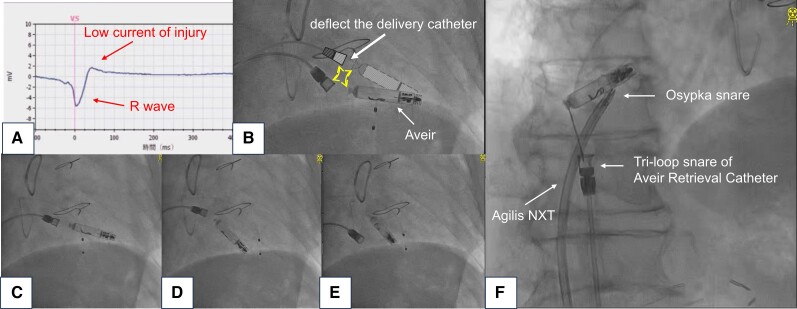An 84-year-old man underwent Aveir™ leadless pacemaker (LP) implantation for bradycardia with atrial fibrillation. In this case, the decision to opt for a LP was influenced by the patient’s advanced age, dementia, and chronic kidney disease (stage 4), which increased the risk of pocket infections. During the procedure, the current of injury was poor, the pacing impedance was 280 Ω, the pacing threshold was 0.5 V/0.4 ms, and the sensing amplitude was 6.5 mV (Figure 1A) at the implantation site. We reassessed the data after a brief period in tether mode; all parameters remained consistent with the initial assessment. The LP remained fixed during the deflection test (Figure 1B) and was released at that site. The tether did not immediately detach from the LP (Figure 1C); however, the LP became dislodged from the myocardium (Figure 1D) and the tether detached from the LP (see Supplementary material online, Movie S1, Figure 1E). The dislodged LP migrated from the right ventricle and floated within the right atrium. To prevent the LP from migrating to the pulmonary artery, we inserted a snare catheter (Osypka Medical GmBH, Berlin, Germany) and an 8.5 Fr steerable sheath (Agilis NXT; St. Jude Medical, St Paul, MN, USA) to grasp the main body, and we caught the docking button with the tri-loop snare of the Aveir retrieval catheter to remove the LP (see Supplementary material online, Movie S2, Figure 1F). After retrieval, we examined the catheter system and consulted the manufacturer; no defects or malfunctions were identified. There are several reports of dislodged LP retrieval, but most are related to the Medtronic Micra™.1,2 There have been few reports of Aveir™ retrieval using double snares.3 Even if the LP passes the deflection test, it is important to check for dislodgement when the current of injury is low.
Figure 1.
(A) EGM following screwing of the leadless pacemaker, indicating a low current of injury. (B) Illustration of the deflection test to confirm leadless pacemaker fixation by delivery catheter deflection. (C–E) Leadless pacemaker dislodgement. (F) Double-snare technique.
Supplementary Material
Contributor Information
Junji Morita, Department of Cardiovascular Medicine, Sapporo Cardiovascular Clinic, North 49, East 16, 8-1, Higashi Ward, Sapporo, Hokkaido 007-0849, Japan.
Yusuke Kondo, Department of Cardiovascular Medicine, Chiba University Graduate School of Medicine, 1-8-1 Inohana, Chuo-ku, Chiba-shi, Chiba 260-8670, Japan.
Yuhei Kasai, Department of Cardiovascular Medicine, Sapporo Cardiovascular Clinic, North 49, East 16, 8-1, Higashi Ward, Sapporo, Hokkaido 007-0849, Japan.
Takayuki Kitai, Department of Cardiovascular Medicine, Sapporo Cardiovascular Clinic, North 49, East 16, 8-1, Higashi Ward, Sapporo, Hokkaido 007-0849, Japan.
Supplementary material
Supplementary material is available at European Heart Journal – Case Reports online.
Consent: The authors confirm that written consent for submission and publication of this case report including image and associated text has been obtained from the patient in line with COPE guidance.
Funding: None declared.
Data availability
The data underlying this article will be shared upon reasonable request to the corresponding author.
References
- 1. Morita J, Kondo Y, Hachinohe D, Kitai T, Fujita T. Retrieval of an infectious leadless pacemaker with vegetation. J Arrhythm 2023;39:71–73. [DOI] [PMC free article] [PubMed] [Google Scholar]
- 2. Afzal MR, Daoud EG, Cunnane R, Mulpuru SK, Koay A, Hussain A, et al. . Techniques for successful early retrieval of the micra transcatheter pacing system: a worldwide experience. Heart Rhythm 2018;15:841–846. [DOI] [PubMed] [Google Scholar]
- 3. Ip JE. Double-snare technique for helix-fixation leadless cardiac pacemaker retrieval. Heart Rhythm 2024;19:S1547-5271(24)00073-0. [DOI] [PubMed] [Google Scholar]
Associated Data
This section collects any data citations, data availability statements, or supplementary materials included in this article.
Supplementary Materials
Data Availability Statement
The data underlying this article will be shared upon reasonable request to the corresponding author.



